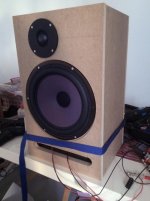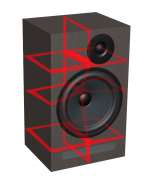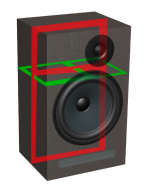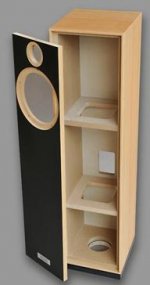Today i got all parts for the seas A26 and could not resist to testrun the speakers in boxes i already build. The baffle cutouts are too big & too small, so i have to make those again. Also the baffles are not glued yet but sort of held in place by a "quick release" cord (is that proper english?)
Long story short, these things sound amazing already! I'm a bit confused about bracing/wall damping however. My not so educated gut guess tells me not to use bracing but instead use bitumen on the side walls to lower the resonance, and glue some damping material over that. Or would some bracing help here? I used 18mm mdf.
According to seas plans the "advanced builder" could use bracing, madisound just uses bitumen like stuff though..
Anyone any good ideas?
Long story short, these things sound amazing already! I'm a bit confused about bracing/wall damping however. My not so educated gut guess tells me not to use bracing but instead use bitumen on the side walls to lower the resonance, and glue some damping material over that. Or would some bracing help here? I used 18mm mdf.
According to seas plans the "advanced builder" could use bracing, madisound just uses bitumen like stuff though..
Anyone any good ideas?
Attachments
According to seas plans the "advanced builder" could use bracing, madisound just uses bitumen like stuff though.
SEAS knows their design best. Stick with their recommendations.
This is an interesting point you raise. 
In my experience, bracing is a very dangerous thing to do. My opinion is that a cabinet's job is to just let vibrations from the drivers flow around without abrupt discontinuities. Then if we are clever, we might damp them a little on each circuit.
The BBC approach is to glue something rubbery or corky and absorbent to the sides and top and bottom. In fact double thickness to the smaller more rigid top and bottom.
http://www.diyaudio.com/forums/multi-way/223174-interesting-read-i-found-lossy-cabinet-designs-harbeth.html#post3234256
Battening is for strength, not rigidity. So the simple approach uses thin and short beech battens to hold the panels together. Because after 20 years or so, they shake themselves loose otherwise. Just 3 thin 2" battens on each panel join will do enough. Spendor have probably overdone it here:
Spendor BC1
You can buy 1/2" thick beech battens at model shops. You'll probably only need a couple of feet length overall.
So glue something absorbent to the sides and top and bottom, which damp vibration each time the energy goes round the cabinet. Then line with some eggcrate foam to absorb frequencies around 3kHz, because foam is only effective near 1/4 wavelength thickness. Then add some BAF wadding to absorb standing waves. I usually place it in a rolled up lump between the magnet and the back of the cabinet to stop chassis ringing.
Little rubber feet of some sort help too. The speakers can then sit on shelves and furniture without rattles.
Well, that's my theory!
In my experience, bracing is a very dangerous thing to do. My opinion is that a cabinet's job is to just let vibrations from the drivers flow around without abrupt discontinuities. Then if we are clever, we might damp them a little on each circuit.
The BBC approach is to glue something rubbery or corky and absorbent to the sides and top and bottom. In fact double thickness to the smaller more rigid top and bottom.
http://www.diyaudio.com/forums/multi-way/223174-interesting-read-i-found-lossy-cabinet-designs-harbeth.html#post3234256
Battening is for strength, not rigidity. So the simple approach uses thin and short beech battens to hold the panels together. Because after 20 years or so, they shake themselves loose otherwise. Just 3 thin 2" battens on each panel join will do enough. Spendor have probably overdone it here:
Spendor BC1
You can buy 1/2" thick beech battens at model shops. You'll probably only need a couple of feet length overall.
So glue something absorbent to the sides and top and bottom, which damp vibration each time the energy goes round the cabinet. Then line with some eggcrate foam to absorb frequencies around 3kHz, because foam is only effective near 1/4 wavelength thickness. Then add some BAF wadding to absorb standing waves. I usually place it in a rolled up lump between the magnet and the back of the cabinet to stop chassis ringing.
Little rubber feet of some sort help too. The speakers can then sit on shelves and furniture without rattles.
Well, that's my theory!
The general rule is to make solid cabinets with good bracing of all walls. However there is a living cult of "lossy cabinets" which means that driver-induced vibrations are conducted to the frame which is constructed in a way to act as mass damper. This however a much more difficult and adventurous way, in my opinion.
SEAS A26 is sorf of vintage design and we have many such speakers that have boxes with thin plywood walls. It sort of begs for that kind of construction, and since it has a port, why not!
-
Some advice here http://www.instructables.com/id/How-To-Build-Your-Own-Cajon-Box-Drum/
http://www.instructables.com/id/How-To-Build-Your-Own-Cajon-Box-Drum/
SEAS A26 is sorf of vintage design and we have many such speakers that have boxes with thin plywood walls. It sort of begs for that kind of construction, and since it has a port, why not!
-
Some advice here
Last edited:
Agree, so i'm going to make a set of boxes with braces; can always go back and cheaper than sealing everything up, go funky with veneers just to think in a few months time "might i have done better"?
Just read this http://www.diyaudio.com/forums/multi-way/172073-bracing-overkill-yay-nay.html thread, would something like my drawing do?
I would make the braces from 18 mm mdf.
And do i need to adjust the cabinet size to make up for the extra room the braces would take?
Just read this http://www.diyaudio.com/forums/multi-way/172073-bracing-overkill-yay-nay.html thread, would something like my drawing do?
I would make the braces from 18 mm mdf.
And do i need to adjust the cabinet size to make up for the extra room the braces would take?
Attachments
Nope. That's terrible. You're just sticking battens across the panels willy nilly! 
You'll just increase wooden colouration to higher frequencies. You'll hear the battens vibrating into the midrange.
The BBC damping idea lets the cabinets flex below 200Hz, but above that, colouration is inaudible.
If you are going to brace, it should be done with panels made of the same stuff as the cabinet.
SEAS CURV
You'll just increase wooden colouration to higher frequencies. You'll hear the battens vibrating into the midrange.
The BBC damping idea lets the cabinets flex below 200Hz, but above that, colouration is inaudible.
If you are going to brace, it should be done with panels made of the same stuff as the cabinet.
SEAS CURV
Ok, new idea;-) How about this? What i get from your link it seems to look like my new sketch; i would make the braces from 18 mm mdf. The vertical plain would be 1 board with cutouts, and the horizontal ones 2 separate boards with cutouts.
Attachments
One more thing, for my leaning curve..Would one extra horizontal brace under the woofer bring anything? Since there isn't much wood on the baffle left i could imagine that that extra brace would tame the coupling from the woofer to the baffle more. On the other hand it would also couple the front to the back more as a trade-off..
Gerben, I'm not against bracing altogether. Just that sometimes it really isn't needed. 
I know you want to get the best out of these, but really, there isn't anything to dislike about the SEAS near-Golden Ratio Cabinet. If you think about it, the bass unit is mostly braced by the side panels.
0.618:1:1.618 is considered near optimal in most respects. Where you go away from that, then bracing and stuffing (for the long axis mode in this reflex tower) will definitely help. Like the MDF WLM La Scala tower design below.
See, if the cabinet is totally rigid, how is the damping on the panels going to flex enough to absorb midrange energy and colouration?
You're going to get a terrific result with little short strengthening beech battens, the glued damping panels, foam lining and some BAF stuffing. It's cost effective and tried and true. Troels Gravesen discusses how he learned to be less anal, and just get on with it below:
Tips and ideas Copyright 2012-14
I know you want to get the best out of these, but really, there isn't anything to dislike about the SEAS near-Golden Ratio Cabinet. If you think about it, the bass unit is mostly braced by the side panels.
0.618:1:1.618 is considered near optimal in most respects. Where you go away from that, then bracing and stuffing (for the long axis mode in this reflex tower) will definitely help. Like the MDF WLM La Scala tower design below.
See, if the cabinet is totally rigid, how is the damping on the panels going to flex enough to absorb midrange energy and colouration?
You're going to get a terrific result with little short strengthening beech battens, the glued damping panels, foam lining and some BAF stuffing. It's cost effective and tried and true. Troels Gravesen discusses how he learned to be less anal, and just get on with it below:
Tips and ideas Copyright 2012-14
Attachments
Well, last night i read more discussions about this including this http://www.diyaudio.com/forums/multi-way/235908-how-brace-speaker-cabinet.html one.
Thing is physics never have been my strongest point, so the discussion i linked quickly turned into something i can't follow 100%, but both ways of looking at it sound logical to me. I have to go with what i learned empirical how materials react.
I have to route new baffles, and make a giant mess in a place not intended for woodworking anyway, so i think building a braced cabinet and see which sounds best to me is the way to go.
System7, do you have a picture link of something beech battened? I googled it and think i get what you mean but just to make sure;-)
Thing is physics never have been my strongest point, so the discussion i linked quickly turned into something i can't follow 100%, but both ways of looking at it sound logical to me. I have to go with what i learned empirical how materials react.
I have to route new baffles, and make a giant mess in a place not intended for woodworking anyway, so i think building a braced cabinet and see which sounds best to me is the way to go.
System7, do you have a picture link of something beech battened? I googled it and think i get what you mean but just to make sure;-)
Your first cabinet effort looks fine to me. The bass rebate is near enough. The tweeter rebate should be easy enough to chisel or cut to size. Flush mounting matters more with tweeters than basses as it goes.
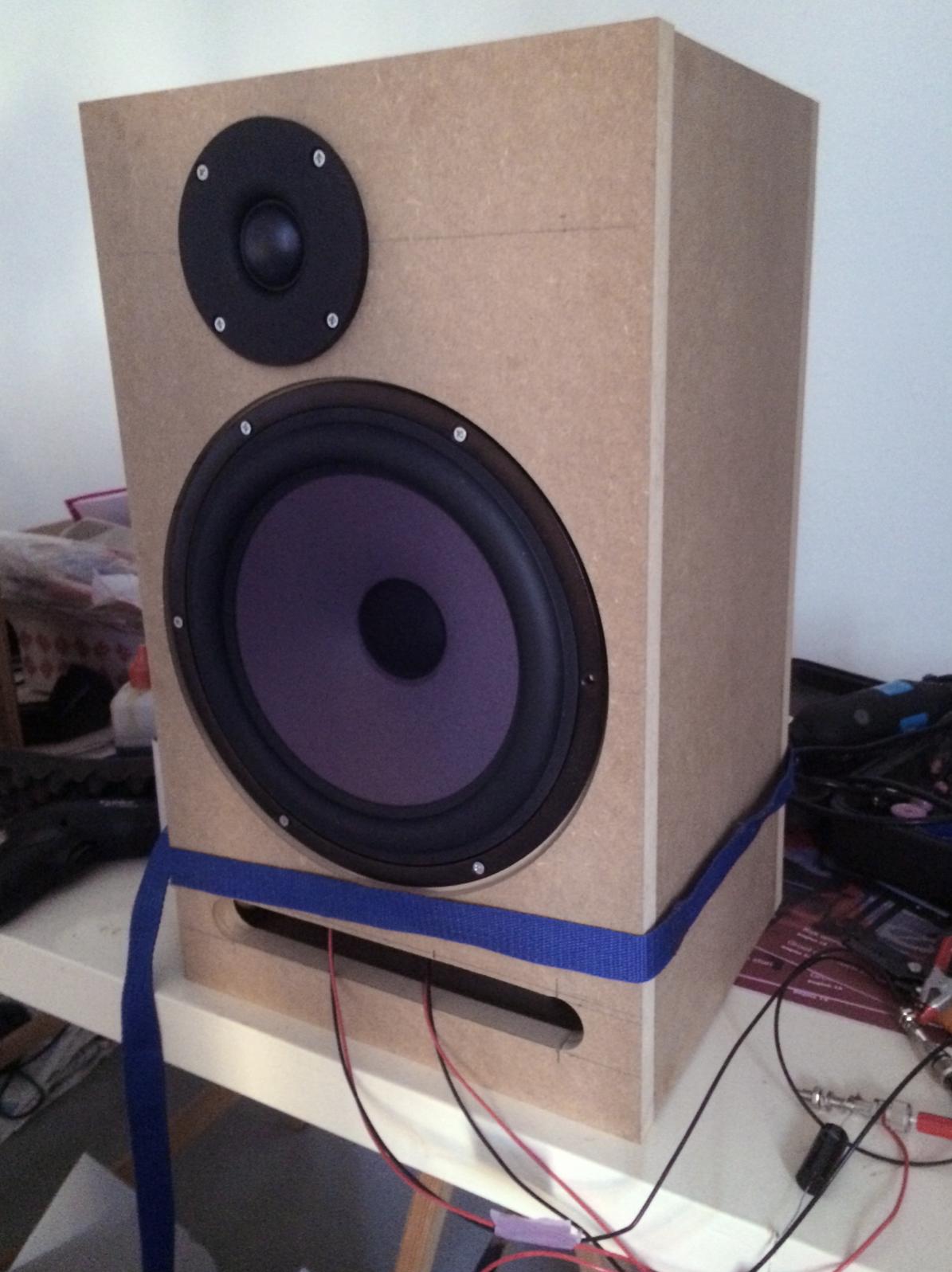
Most of those old BBC designs were made for removeable front and occasionally rear baffles. You're not taking that approach. I'd just stick 1 or 2 short small battens either side of the bass unit in the join to the sides. It just holds the joins together better, strengthening the cabinet in the long term without affecting the sound.
You could dot a few more around on the other panels too. If you do the damping carefully, you are way ahead of the standard of most commercial speakers.

Most of those old BBC designs were made for removeable front and occasionally rear baffles. You're not taking that approach. I'd just stick 1 or 2 short small battens either side of the bass unit in the join to the sides. It just holds the joins together better, strengthening the cabinet in the long term without affecting the sound.
You could dot a few more around on the other panels too. If you do the damping carefully, you are way ahead of the standard of most commercial speakers.
Advice by Håvard Sollien at SEAS
I wondered the exact same things, and thought I'd ask SEAS themselves. What do you know, no one other than Håvard Sollien himself was kind enough to offer his advice, designer of the A26 and Manager R&D at SEAS. A huge thumbs up!
Asking if the cabinet interior should be lined, and if so, using what kind of material, he replied:
World Designs suggested a bracing design that I thought was pretty smart: WD25a Construction pg1. Asking Håvard's opinion, he then replied:
So there you have it. A+ customer support!
Now all that's left to decide is the type and make of capacitor and resistor.
I wondered the exact same things, and thought I'd ask SEAS themselves. What do you know, no one other than Håvard Sollien himself was kind enough to offer his advice, designer of the A26 and Manager R&D at SEAS. A huge thumbs up!
Asking if the cabinet interior should be lined, and if so, using what kind of material, he replied:
It's a good thing to line the interior with felt or wool. This is of course in addition to the polyfill damping that should be evenly distributed in the box.
World Designs suggested a bracing design that I thought was pretty smart: WD25a Construction pg1. Asking Håvard's opinion, he then replied:
I'm not sure how much sonic difference the extra bracing does in this cabinet, but it’s good to stiffen the cabinet and support the magnet system.
So there you have it. A+ customer support!
Now all that's left to decide is the type and make of capacitor and resistor.
Hi Gerben
Just having put new surrounds on a pair of SEAS 25 cm woofers, very like yours, it struck me how flimsy the cast chassis of these drivers is, in particular in combination with the rather heavy magnet assembly. That entire assembly is prone to serious rocking, transmitting all sorts of undesirable powers to the frontpanel.
I therefore would suggest not to front mount the chassi (leaving the magnet unsupported) but rather attach the woofer at its magnet/glue the magnet into a thick cardboard pipe (15 cm/6" approx. dia) or some similar contraption and attach the entire assembly to back panel, or a combi of back/side/top/bottom of the enclosure. Isolate the chassis from the front panel by thick foam tape.
BTW I am curious to learn how the many experts here will react to this suggestion.
Furthermore I would suggest to glue another layer of 6 mm MDF to the existing enclosures.
Good luck and have fun.
BTW II oversize panels can simply be routed to the correct size instead of making new ones.
Regards,
Eelco
Just having put new surrounds on a pair of SEAS 25 cm woofers, very like yours, it struck me how flimsy the cast chassis of these drivers is, in particular in combination with the rather heavy magnet assembly. That entire assembly is prone to serious rocking, transmitting all sorts of undesirable powers to the frontpanel.
I therefore would suggest not to front mount the chassi (leaving the magnet unsupported) but rather attach the woofer at its magnet/glue the magnet into a thick cardboard pipe (15 cm/6" approx. dia) or some similar contraption and attach the entire assembly to back panel, or a combi of back/side/top/bottom of the enclosure. Isolate the chassis from the front panel by thick foam tape.
BTW I am curious to learn how the many experts here will react to this suggestion.
Furthermore I would suggest to glue another layer of 6 mm MDF to the existing enclosures.
Good luck and have fun.
BTW II oversize panels can simply be routed to the correct size instead of making new ones.
Regards,
Eelco
Hi Eelco,
Are we talking about the same 26,9 cm A26RE4, the 1141-08? The units I have are not flimsy at all. Their baskets are made of rather large and stiff steel support struts.
Regardless, extra support for the magnet seems like a good idea. I'm following the World Designs concept, which has very low coupling from front to back by design.
Kind regards,
Roderick
Are we talking about the same 26,9 cm A26RE4, the 1141-08? The units I have are not flimsy at all. Their baskets are made of rather large and stiff steel support struts.
Regardless, extra support for the magnet seems like a good idea. I'm following the World Designs concept, which has very low coupling from front to back by design.
Kind regards,
Roderick
Build blog
I finished my A26's and they sound awesome.

I posted an extensive write-up on my blog: https://www.vandomburg.net/audio/do-it-yourself-speaker-project-seas-a26/.
I finished my A26's and they sound awesome.

I posted an extensive write-up on my blog: https://www.vandomburg.net/audio/do-it-yourself-speaker-project-seas-a26/.
- Status
- This old topic is closed. If you want to reopen this topic, contact a moderator using the "Report Post" button.
- Home
- Loudspeakers
- Multi-Way
- Seas A26 aperiodic bracing & damping
